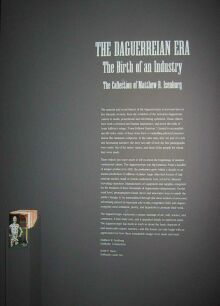 Some photographs from:
Some photographs from:
THE DAGUERREIAN ERA
The Birth of an Industry
The Collection of Matthew R. Isenburg
 The material and social history of the
daguerreotype is surveyed here in five thematic sections, from the evolution of
the American daguerreian camera to studio promotional and advertising ephemera.
These objects have both a technical and human importance, and prove the truth of
Louis Sullivan's adage, "Form Follows Function." Created to accomplish specific
tasks, many of these items have a compelling physical presence, almost like
miniature sculptures. At the same time, they are part of a rich and fascinating
narrative: the story not only of how the first photographs were made, but of the
tastes, values and ideas of the people for whom they were made.
The material and social history of the
daguerreotype is surveyed here in five thematic sections, from the evolution of
the American daguerreian camera to studio promotional and advertising ephemera.
These objects have both a technical and human importance, and prove the truth of
Louis Sullivan's adage, "Form Follows Function." Created to accomplish specific
tasks, many of these items have a compelling physical presence, almost like
miniature sculptures. At the same time, they are part of a rich and fascinating
narrative: the story not only of how the first photographs were made, but of the
tastes, values and ideas of the people for whom they were made.
These objects also have much to tell us about the beginnings of modern
commercial culture. The daguerreotype was big business. From a handful of images
produced in 1839, the profession grew within a decade to an annual production of
millions of plates. Large cities had dozens of daguerreian studios; small or
remote settlements were served by intinerant (traveling) operators.
Manufacturers of equipment and supplies competed for the business of these
thousands of daguerreian entrepreneurs. On the retail level, photographers found
clever and innovative ways to satisfy the public's hunger to be immortalized
through this most modern of processes. Advertising played an important role in
this competitive field, and daguerreotypists used sentiment, poetry and
hyperbole to promote their work.
The daguerreotype represents a unique marriage of art, craft, science and
commerce. It had many uses, and it appealed deeply to American tastes. The
daguerreotype has much to teach us about the basic character of
mid-nineteenth-century America—and this lesson can only begin with an
appreciation for how these remarkable images were made and used.
Matthew R. Isenburg
Hadlyme, Connecticut
Keith F. Davis
Hallmark Cards, Inc.
NEXT

Home |
Introduction | Awaiting the
Sitter | The
Presentation | Cameras |
Ephemera
| The Process
 The material and social history of the
daguerreotype is surveyed here in five thematic sections, from the evolution of
the American daguerreian camera to studio promotional and advertising ephemera.
These objects have both a technical and human importance, and prove the truth of
Louis Sullivan's adage, "Form Follows Function." Created to accomplish specific
tasks, many of these items have a compelling physical presence, almost like
miniature sculptures. At the same time, they are part of a rich and fascinating
narrative: the story not only of how the first photographs were made, but of the
tastes, values and ideas of the people for whom they were made.
The material and social history of the
daguerreotype is surveyed here in five thematic sections, from the evolution of
the American daguerreian camera to studio promotional and advertising ephemera.
These objects have both a technical and human importance, and prove the truth of
Louis Sullivan's adage, "Form Follows Function." Created to accomplish specific
tasks, many of these items have a compelling physical presence, almost like
miniature sculptures. At the same time, they are part of a rich and fascinating
narrative: the story not only of how the first photographs were made, but of the
tastes, values and ideas of the people for whom they were made.